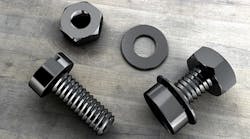Conventional assembly methods cause assemblers to inefficiently fumble with screws that are stored in bins or shaker trays. Fumbling isn’t just a football occurrence. Daily, assembly operators using power tools fumble around picking up screws from bins and slowly align the fasteners onto a bit. In an attempt to grab one fastener at a time, several screws often stick to the operator’s fingers. Screws can easily be dropped across a workstation or fumbled to the ground. Smaller the fastener is, the more extensive the challenge becomes for an operator to efficiently pick-up a screws from a bin and perform the fastening process in a timely, productive manner.
The constant repetition of picking-up and fumbling around with hundreds and hundreds of screws on a daily basis impacts productivity and costs. It’s an unnecessary expense and an inefficient process. And, a potential health hazard if fasteners are dropped and left on the floor, allowing an opportunity for an individual to slip and fall.
Using a screw presenter during the fastening process is a productive option to consider. A tabletop screw presenter is typically small and compact. It is used to organize and automate work areas and production cells. Screw presenters make assemblers and the assembly process more efficient by mechanically presenting a screw to a fixed pick up point. These feeders can be used in combination with most any assembly application and power tool. Alternative methods of presenting a screw are cumbersome and very expensive.
Assembly Process Improvements with a Screw Presenter
- Eliminate slow process of picking-up screws from bins
- Make the fastening process more efficient
- Screw feeding system organizes & automates the assembly area
- Screw presenters operate with power assembly tools
A screw presenter is simple machine to operate. The fasteners are poured into the hopper of the screw presenter and automatically line up for dispensing. This simple mechanism allows trouble-free operation, eliminating jammed or stuck screws. The screws are aligned along the screw-feeding rail with one fastener exposed and sitting in the bit guide. Once the bit of the power assembly tool engages with the screw head and the fastener is removed, then another screw automatically dispenses to the bit guide and is ready for an easy pick-up. No fumbling with screws.
For a power tool to pick-up a fastener from the screw presenter there are two standard options. Either the bit used with assembly tool is magnetized or a power tool is equipped with a vacuum adapter kit. A magnetized bit will retrieve most screws from the screw presenter. For non-magnetic and stainless screws, an assembly tool will require a suction attachment to pick up fasteners from the screw presenter.
Some screw presenter models have a limited fastener size capacity that can be utilized with the machine. While other models may require you to purchase an additional a screw-feeding rail in order to adapt a different screw size. There are flexible screw presenters that are fully adjustable. These models can be adjusted to accommodate a wide variety of screw sizes. No need to change or purchase additional rails. Always select a tool that best fits your fastening application.
When using a screw presenter in the fastening process, the typical pick-up rate capacity is up to two screws per second. The enhancement of productivity is estimated to improve assembly time by nearly fifty percent.
Using a quality screw feeding system makes a safer world through accuracy and precision. Controlling torque is essential for companies to ensure their product’s quality, safety and reliability isn’t compromised. The failure of a three-cent fastener that isn’t properly tightened can lead to catastrophic or latent failures. Fasteners that are insufficiently fastened can vibrate loose and excessive torque can strip threaded fasteners.
Stop screw fumbles. Take steps to the improve assembly process. Implement equipment that will make the fastening process more efficient.










